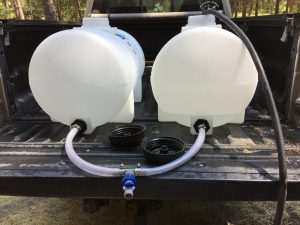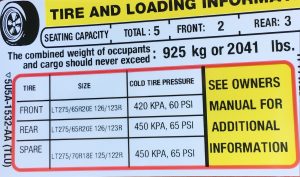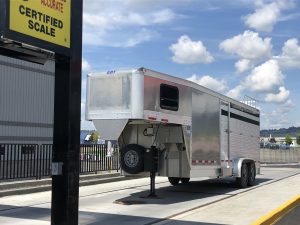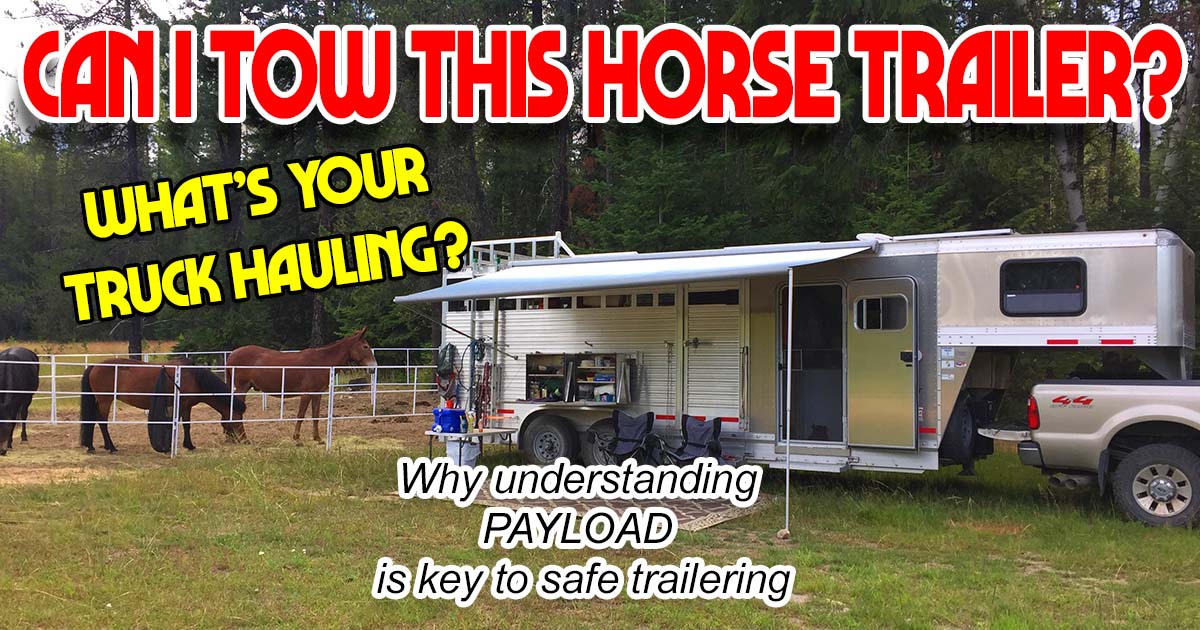“Can I tow this horse trailer?” It’s a common question that I hear regularly at my horse camping clinics.
Safely towing a horse trailer can be confusing. It seems that there are a million different acronyms to learn and know. GCWR, GAWR, Tow Rating, Payload, and many more. What do all these things mean? Understanding these acronyms and numbers can be confusing without a degree in “Towology.” And, if you get it wrong, you or your horses can get hurt.
Let’s take the mystery out of one of these figures and talk about PAYLOAD Ratings – What it is and how to find yours. Most of us have an idea about towing ratings. But payload is something else entirely. We’ve all heard it – I’ve got a ¾ ton truck, and the dealer says it can tow 21,000 lbs. That’s nice, but what can it carry? You see what you can tow and what you can handle are two different things.
Towing Acronyms
It’s important to know this information before hitting the road. You could easily overload your truck if you aren’t aware of your vehicle’s GVWR, curb weight, and payload capacity. Know and understand this information before you tow, and you’re going to be much safer in the long run.
No matter what type of trailer you’re towing, payload ratings are important. Your payload rating is how much weight you can carry in your truck, and the tow rating is how much weight your truck can pull. The tow rating is the big sexy number you see touted in advertising campaigns, and the payload rating is a much smaller figure that is not widely advertised. It’s how much weight you can put in the truck before something runs a risk of breaking. Payload is always a factor in bumper pull towing, and it’s a bigger deal than you may think in gooseneck towing.
 Truck manufacturers often advertise their truck’s capacities. These values, however, are the maximums for when the vehicle has only a driver in it and no cargo. Such a scenario isn’t realistic for horse campers. You will likely have passengers and other cargo in the truck, such as camping gear and horse feed. These extras add weight to the vehicle, lowering the payload and towing capacities. You’d think with a considerable tow rating that you’d have to have a payload rating to match. Not necessarily. Not every truck manufacturer bulks up payload capacity along with the tow rating.
Truck manufacturers often advertise their truck’s capacities. These values, however, are the maximums for when the vehicle has only a driver in it and no cargo. Such a scenario isn’t realistic for horse campers. You will likely have passengers and other cargo in the truck, such as camping gear and horse feed. These extras add weight to the vehicle, lowering the payload and towing capacities. You’d think with a considerable tow rating that you’d have to have a payload rating to match. Not necessarily. Not every truck manufacturer bulks up payload capacity along with the tow rating.
There’s a lot of marketing involved from the truck and trailer industries designed to push you into purchasing a vehicle. Manufacturers and dealers have a vested interest in selling you a truck or trailer regardless of whether your vehicles are appropriate for each other.
Finding Payload
Now that we know what a payload rating is, where do we find it? It’s easy! In newer vehicles, it’s on a sticker on the driver’s door frame. If your truck is missing this sticker, you can calculate your truck’s payload capacity on your own by doing a little math:
Start with the maximum total weight your truck can handle, known as its Gross Vehicle Weight Rating (GVWR). GVWR is determined by the manufacturer and is listed in your owner’s manual and door placard.
 Curb Weight is the weight of your vehicle, and it refers to how much your truck weighs when it’s sitting at the curb and not in use. It does not include passengers, cargo, road snacks, or the family dog. I load my truck as if I were going camping and take it to a scale for a more accurate weight.
Curb Weight is the weight of your vehicle, and it refers to how much your truck weighs when it’s sitting at the curb and not in use. It does not include passengers, cargo, road snacks, or the family dog. I load my truck as if I were going camping and take it to a scale for a more accurate weight.
Subtract your truck’s curb weight from its GVWR—that’s your payload capacity.
Your Payload Capacity refers to all of the additional weight you can safely add to your vehicle’s curb weight, including cargo, passengers, AND trailer tongue or pin weight. For example, if your truck’s GVWR is 14,000 lbs. and weighs 9,272 lbs. empty, your payload capacity is 4,728 lbs. You can put 4,728 lbs. of people, stuff, and pin weight in this truck. (Example is for a 2019 F-450 diesel.)
Try for yourself.
Take the payload rating and start subtracting. You should have a positive number when you’re finished calculating. If not, your truck is overloaded.
 Here’s a 2017 Ford F-250 4WD diesel ¾ ton truck.
Here’s a 2017 Ford F-250 4WD diesel ¾ ton truck.
- Per the manufacturer towing guide, it can pull 14,700 pounds.
- Per the sticker on the door frame, it has a payload of 2,041 pounds
Let’s see how quickly we go through those 2,041 pounds.
Weight of any passengers – BTW, the manufacturers’ calculations assume that drivers weigh just 150 pounds.
Let’s say there’s just one passenger – the average American weighs 181 pounds. Now we have 1870 pounds of capacity remaining. What else do we carry in the cab when horse camping?
Cargo in the truck – coolers, camping gear, etc., Do you carry water tanks or bales of hay in the truck bed?
We’re prepared and have 70 gallons of water and two bales of hay in the bed of the truck. That weighs 731 pounds, and now we have 1,139 pounds of capacity remaining.
What about aftermarket options on the truck, such as brush guards or towing attachments. You also need to subtract those from your payload.
And what is the tongue or hitch weight of the trailer? Hitch weight is a HUGE factor that many people don’t consider. The downward pressure on the hitch is where things can quickly become very interesting.
Hitch Weight
The axles on horse trailers are found further back on the trailer than on an RV (they’re way back there to provide a smoother ride for our horses). When the tires are that far back, more of trailer’s weight is resting on your truck.
Your trailer’s tongue, hitch, or pin weight isn’t hard to determine, but it can be a hassle.
You see, while most manufacturers list the base model weight for their trailers, most don’t list the tongue weight. The few that do give you a weight when the trailer is EMPTY. No horses, no tack, no battery, no cargo, no nothing. So, your hitch weight is going to be much more once you’ve loaded the trailer for a trip.
 The best way to find your hitch or tongue weight is to load your trailer the way you usually do for a camping trip, including horses, and take it to a scale.
The best way to find your hitch or tongue weight is to load your trailer the way you usually do for a camping trip, including horses, and take it to a scale.
For this modest 22-foot stock trailer, the hitch weight from the scales is 1,820 pounds.
All of those figures foot up to 2,765 pounds of weight resting on the truck’s frame, which makes this truck overloaded by 681 pounds. This may not seem like much, and people continually tell me that a ¾ ton truck is all you need to haul a horse trailer. I’m sorry, but the numbers don’t lie.
Choose who to listen to
The “I do it, and it’s fine” crowd of self-appointed experts found on social media, or the trailer salesman, or the truck dealer, aren’t the people that are going to pay the fine when you get caught with an overloaded truck. Cops are trained to spot the signs of an overloaded vehicle. If they suspect you’re driving one, they can pull you over and weigh you with a roadside scale. If your weight exceeds your truck’s weight ratings, they can ticket you or, in extreme cases, impound your rig on the spot. Furthermore, exceeding your weight ratings can invalidate your insurance, push liability in your direction in the event of a crash, and even lead to charges of negligence.
It’s all avoidable. When in doubt, visit a scale and see what your vehicle weighs fully loaded down for a camping trip.
For more information regarding trail riding and horse camping, as well as the world’s largest and only accurate guide to horse camps, visit me at www.TrailMeister.com. You can also find more of my ponderings in my book—The ABCs of Trail Riding and Camping with Horses – Available on Amazon – Click Here.


